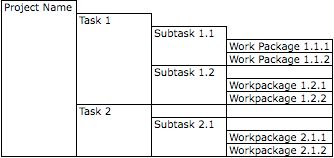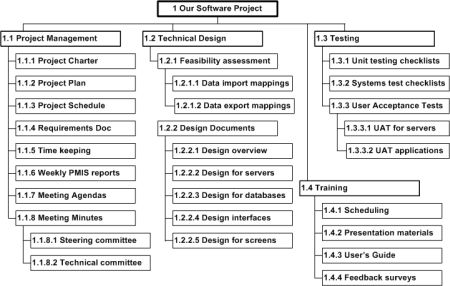A work breakdown structure (WBS), in project management and systems engineering, is a deliverable-oriented decomposition of a project into smaller components.
A work breakdown structure element may be a product, data, service, or any combination thereof. A WBS also provides the necessary framework for detailed cost estimating and control along with providing guidance for schedule development and control.
A work breakdown structure is a key project deliverable that organizes the team’s work into manageable sections. The work breakdown structure can be defined as a “deliverable oriented hierarchical decomposition of the work to be executed by the project team.” The work breakdown structure visually defines the scope into manageable chunks that a project team can understand, as each level of the work breakdown structure provides further definition and detail.
Construction of a WBS
Identifying the main deliverables of a project is the starting point for deriving a work breakdown structure.
This important step is usually done by the project managers and the subject matter experts (SMEs) involved in the project. Once this step is completed, the subject matter experts start breaking down the high-level tasks into smaller chunks of work.
In the process of breaking down the tasks, one can break them down into different levels of detail. One can detail a high-level task into ten sub-tasks while another can detail the same high-level task into 20 sub-tasks.
Therefore, there is no hard and fast rule on how you should breakdown a task in WBS. Rather, the level of breakdown is a matter of the project type and the management style followed for the project.
In general, there are a few “rules” used for determining the smallest task chunk. In “two weeks” rule, nothing is broken down smaller than two weeks worth of work.
This means, the smallest task of the WBS is at least two-week long. 8/80 is another rule used when creating a WBS. This rule implies that no task should be smaller than 8 hours of work and should not be larger than 80 hours of work.
One can use many forms to display their WBS. Some use tree structure to illustrate the WBS, while others use lists and tables. Outlining is one of the easiest ways of representing a WBS.
Following example is an outlined WBS:

There are many design goals for WBS. Some important goals are as follows:
- Giving visibility to important work efforts.
- Giving visibility to risky work efforts.
- Illustrate the correlation between the activities and deliverables.
- Show clear ownership by task leaders.
WBS Diagram
In a WBS diagram, the project scope is graphically expressed. Usually the diagram starts with a graphic object or a box at the top, which represents the entire project. Then, there are sub-components under the box.
These boxes represent the deliverables of the project. Under each deliverable, there are sub-elements listed. These sub-elements are the activities that should be performed in order to achieve the deliverables.
Although most of the WBS diagrams are designed based on the deliveries, some WBS are created based on the project phases. Usually, information technology projects are perfectly fit into WBS model. Therefore, almost all information technology projects make use of WBS.
In addition to the general use of WBS, there is specific objective for deriving a WBS as well. WBS is the input for Gantt charts, a tool that is used for project management purpose. Gantt chart is used for tracking the progression of the tasks derived by WBS.
Following is a sample WBS diagram:


